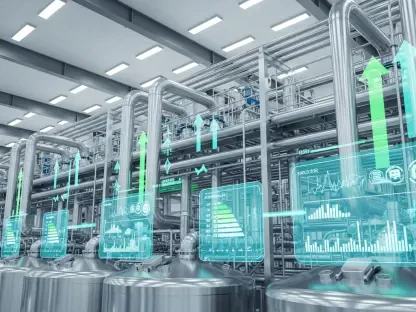The relentless march of artificial intelligence (AI) is revolutionizing industries and everyday life, yet it casts a long shadow over environmental sustainability due to the immense resource demands of the data centers that fuel it, as highlighted by a pioneering study from Cornell University. This research offers a sobering state-by-state examination of the energy consumption and water usage associated with these facilities across the United States. It not only quantifies the alarming scale of carbon emissions and water depletion tied to AI infrastructure but also lays out a strategic roadmap to mitigate these impacts. With AI’s growth showing no signs of slowing, the findings underscore a critical tension between technological advancement and the pressing need to protect natural resources. This balance is not just a technical challenge but a societal imperative, as unchecked expansion could undermine global sustainability goals. The Cornell analysis serves as both a warning and a guide, urging stakeholders to rethink how and where AI’s backbone is built.
Uncovering the Resource Burden of AI Growth
The computational power driving AI innovations comes at a steep environmental cost, as data centers consume vast amounts of electricity and water to operate and cool their systems. These facilities, often running 24/7, rely heavily on energy grids that are still predominantly powered by fossil fuels, contributing significantly to greenhouse gas emissions. Simultaneously, the water used for cooling servers places immense pressure on local supplies, particularly in regions already grappling with scarcity. The Cornell study projects that by 2030, AI data centers could release up to 44 million metric tons of carbon dioxide each year, an amount comparable to the emissions of 10 million additional cars on U.S. roads. Water consumption is equally staggering, with estimates reaching over 1,000 million cubic meters annually—enough to meet the household needs of 10 million Americans. These figures highlight a trajectory that clashes with the AI industry’s aspirations for net-zero emissions, painting a picture of an urgent problem demanding immediate attention.
Beyond the raw numbers, the placement of data centers plays a pivotal role in amplifying or mitigating their environmental footprint. Many existing facilities are situated in areas ill-suited to handle such resource demands, such as arid states like Nevada and Arizona, where water is already a precious commodity, or densely packed hubs like northern Virginia, where local grids and ecosystems are strained. This poor siting exacerbates the depletion of critical resources and increases the carbon intensity of operations when renewable energy sources are not readily available. The research emphasizes that location is not a trivial detail but a fundamental factor in determining the sustainability of AI infrastructure. Addressing this issue requires a shift in planning priorities, moving away from convenience or legacy decisions toward a more environmentally conscious approach that considers regional resource availability and long-term ecological impacts.
Mapping a Greener Future for Data Centers
Hope emerges from the Cornell study through its identification of more sustainable locations for building AI data centers, where access to renewable energy and lower resource stress can make a significant difference. Regions such as the Midwest and the so-called “wind belt” states, including Texas, Montana, Nebraska, and South Dakota, are highlighted as promising options due to their abundant wind power potential and relatively lower water constraints. Similarly, New York State stands out as a low-carbon choice, benefiting from a robust mix of nuclear, hydropower, and other renewable energy sources, though improvements in water-efficient cooling technologies remain essential. By strategically placing new facilities in these areas, the industry could substantially reduce its environmental toll. The study’s roadmap suggests that such decisions, if made with foresight, could align AI growth with broader sustainability objectives, setting a precedent for responsible development.
Another critical pillar of the proposed strategy focuses on accelerating the decarbonization of energy grids to keep pace with AI’s escalating demands. Even as energy production becomes cleaner per kilowatt-hour, the sheer volume of AI-driven consumption could still drive a 20% increase in total emissions unless renewable energy adoption is significantly ramped up. The research estimates that achieving net-zero emissions would require an additional 28 gigawatts of wind power or 43 gigawatts of solar capacity—a monumental but necessary investment. This underscores the urgency of aligning AI infrastructure expansion with the transition to green energy sources. Without such synchronization, the benefits of cleaner grids risk being outstripped by the relentless growth of computational needs, locking in higher emissions for decades. The path forward demands collaboration between tech companies, utilities, and policymakers to prioritize renewable energy projects in regions hosting AI facilities.
Harnessing Technology for Environmental Gains
Technological innovation offers a powerful avenue to lessen the environmental burden of AI data centers, with operational efficiencies emerging as a game-changer in the sustainability equation. Advanced cooling methods, such as liquid cooling, present a viable alternative to traditional water-heavy systems, potentially cutting water usage by 29%. Similarly, optimizing server utilization to reduce idle times can trim carbon emissions by an additional 7%. When these improvements are integrated with strategic siting and renewable energy adoption, the Cornell roadmap projects remarkable reductions—up to 73% in carbon emissions and 86% in water use compared to worst-case scenarios. These figures illustrate that technology, often the root of the problem, can also be part of the solution if deployed with intent. The challenge lies in scaling these innovations across an industry historically focused on performance over efficiency, requiring both investment and a shift in operational mindset.
Moreover, the emphasis on efficiency extends beyond hardware to encompass broader systemic changes in how data centers are managed and integrated into energy ecosystems. The study advocates for smarter workload distribution, where computational tasks are dynamically allocated to facilities with access to surplus renewable energy at any given time, minimizing reliance on dirtier power sources. Such approaches, while complex to implement, could further shrink the carbon footprint of AI operations. Additionally, partnerships with energy providers to prioritize green power contracts can incentivize cleaner production tailored to data center needs. This multi-layered strategy reveals that sustainability is not a single fix but a tapestry of interconnected solutions. By weaving together cutting-edge tech with forward-thinking policies, the industry can pivot toward a model where growth and environmental stewardship are not at odds but in harmony.
Building a Sustainable Legacy for AI
Reflecting on the Cornell findings, it becomes evident that the AI boom stands at a critical juncture, where past decisions have often prioritized speed and scale over environmental consequences. The research paints a stark picture of escalating carbon emissions and water depletion, driven by unchecked expansion and suboptimal infrastructure choices. Yet, through meticulous analysis, it also illuminates a path forward, blending optimized locations, rapid grid decarbonization, and innovative technologies to curb impacts significantly. The collaborative effort, involving experts from multiple countries, reinforces the global stakes of this issue, showing that the challenge transcends borders.
Looking ahead, the next steps hinge on actionable commitments from industry leaders, policymakers, and utility providers to implement the roadmap’s recommendations without delay. Prioritizing data center placement in resource-abundant regions, scaling renewable energy capacity to match AI’s hunger, and investing in efficiency upgrades are non-negotiable moves to ensure a greener trajectory. The legacy of AI could be one of transformation, not just in technology but in demonstrating how innovation and sustainability can coexist, provided the resolve to act is matched by coordinated effort across sectors.









